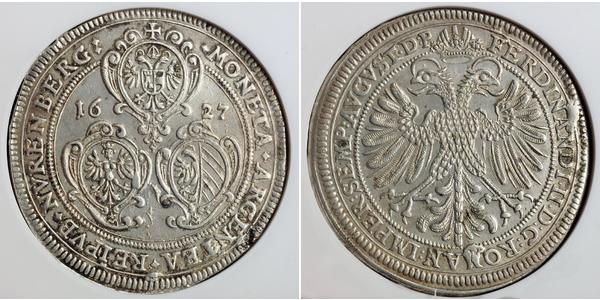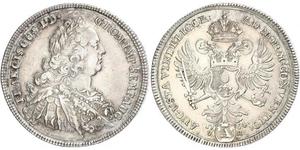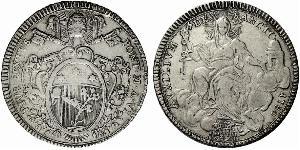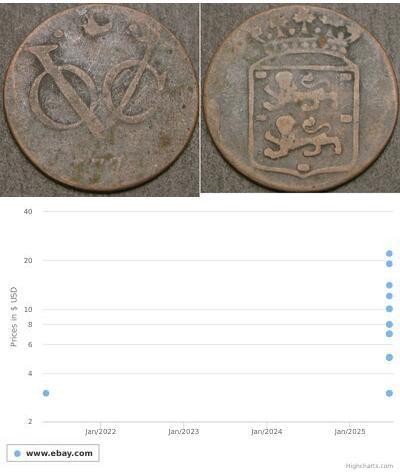(Venduta per $308.0)
1627, Nuremberg (Free City), Ferdinand II. Large Silver Thaler Coin. NGC AU+
Mint Year: 1627 Denomination: Thaler Mint Master: G. Nürnberger (elder, 1622-1657) Reference: Davenport 5642, Kellner 235, KM-88. R! Mint Place: Nuremberg (as free City within the Holy Roman Empire). Condition: Certified and graded by NGC as AU (Details: Cleaned!) Weight: 28.46gm Diameter: 43mm Material: Silver Obverse: Winged cupid, holding olive- and palm-branches in hands, supporting framed drop-shaped arms of Nuremberg at sides. A third oval shield within baroque frame above. Date (16Z8), flanked by dots below. Legend: . MONETA . NOUA . ARGENTEA . REIPUB . NORIMBERG . +
Reverse: Imperial crown above cross-topped orb and double-headed imperial eagle with sword and scepter in claws and halved shield at chest, surmounted by Toison d'or chain. Legend: . FERDINAND : II . D . G : ROM : IMP : SEM : AUG : G : H : B : R :
Nuremberg is a city situated on the Pegnitz river and the Rhine-Main-Danube Canal. It is located about 170 kilometres north of Munich. The cultural flowering of Nuremberg in the 15th and 16th centuries made it the center of the German Renaissance. In 1525, Nuremberg accepted the Protestant Reformation, and in 1532, the religious Peace of Nuremberg, by which the Lutherans gained important concessions, was signed there. In 1632 during the Thirty Years' War, the city, occupied by the forces of Gustavus Adolphus of Sweden, was besieged by the army of Imperial general Albrecht von Wallenstein.
Ferdinand II, Holy Roman Emperor (July 9, 1578 – February 15, 1637), of the House of Habsburg, reigned as Ferdinand II, Archduke of Inner Austria (normally called Ferdinand II of Germany when referred to as Archduke) and Holy Roman Emperor from 1619-1637. He was also the Archduke of Styria (Inner Austria) from 1590–1637, King of Bohemia from 1617-1619 and again from 1620-1637, as well as King of Hungary and Croatia from 1618-1625. The expansion of the ongoing acts of rebellion against his Imperial Governors in Bohemia on May 23rd, 1618 directly triggered the Thirty Years' War, and can be blamed on his religious intolerance toward Protestants.
A devout and very pious Catholic, his recognition as King of Bohemia and suppression of Protestantism precipitated the early events of the Thirty Years' War, and he remained one of the staunchest backers of the Anti-Protestant Counter Reformation efforts as one of the heads of the German Catholic League, prolonging the Thirty Years' Wars by insisting the Edict of Restitution be enforced. The duration of his reign was occupied by confessional and military concerns, and some historians blame him for the large civilian loss of life in the Sack of Magdeburg in 1631, as he'd instructed Count Tilly to enforce the edict upon Saxony—his orders causing Tilly to move the Catholic armies east, ultimately to Leipzig, where they suffered their first substantial defeat at First Breitenfeld.
(July 9, 1578 – February 15, 1637), of the House of Habsburg, reigned as Ferdinand II, Archduke of Inner Austria (normally called Ferdinand II of Germany when referred to as Archduke) and Holy Roman Emperor from 1619-1637. He was also the Archduke of Styria (Inner Austria) from 1590–1637, King of Bohemia from 1617-1619 and again from 1620-1637, as well as King of Hungary and Croatia from 1618-1625. The expansion of the ongoing acts of rebellion against his Imperial Governors in Bohemia on May 23rd, 1618 directly triggered the Thirty Years' War, and can be blamed on his religious intolerance toward Protestants.
A devout and very pious Catholic, his recognition as King of Bohemia and suppression of Protestantism precipitated the early events of the Thirty Years' War, and he remained one of the staunchest backers of the Anti-Protestant Counter Reformation efforts as one of the heads of the German Catholic League, prolonging the Thirty Years' Wars by insisting the Edict of Restitution be enforced. The duration of his reign was occupied by confessional and military concerns, and some historians blame him for the large civilian loss of life in the Sack of Magdeburg in 1631, as he'd instructed Count Tilly to enforce the edict upon Saxony—his orders causing Tilly to move the Catholic armies east, ultimately to Leipzig, where they suffered their first substantial defeat at First Breitenfeld.
Only 1$ shipping for each additional coin purchased!
























